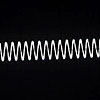-

-
Courses
Find courses by:
Collections
Cross-Disciplinary Topic Lists
- About
- Donate
- Featured Sites

 |
|
By the end of this lecture, you should:
› View/hide answer
Comparison of the second and fourth lines shows that \[\frac{1}{{{v^2}}}\frac{{{\partial ^2}y}}{{\partial {t^2}}} = \frac{{{\partial ^2}y}}{{\partial {x^2}}}\]as the wave equation requires, so that \[y = A\sin \left[ {\frac{{2\pi }}{\lambda }(x - vt)} \right]\]is indeed a solution. As in the example of a Gaussian pulse, the chain rule has been applied in taking derivatives. This wave, however, is nominally of infinite extent in space (along x) and exists for all times.
› View/hide answer
To satisfy the wave equation we must have \[\frac{1}{{{v^2}}}\frac{{{\partial ^2}y}}{{\partial {t^2}}} = \frac{{{\partial ^2}y}}{{\partial {x^2}}}.\] Taking the derivatives, \[\begin{gathered} \frac{{\partial y}}{{\partial t}} = \omega 2A\sin (kx)\sin (\omega t)\quad \frac{{{\partial ^2}y}}{{\partial {t^2}}} = {\omega ^2}2A\sin (kx)\cos (\omega t) \ \\ \frac{{\partial y}}{{\partial x}} = k2A\cos (kx)\cos (\omega t)\quad \frac{{{\partial ^2}y}}{{\partial {x^2}}} = {k^2}2A\sin (kx)\cos (\omega t) \ \\ \end{gathered} \] So, \[\frac{{{k^2}}}{{{\omega ^2}}}\frac{{{\partial ^2}y}}{{\partial {t^2}}} = \frac{{{\partial ^2}y}}{{\partial {x^2}}}\] which is the wave equation provided \[\frac{1}{{{v^2}}} = \frac{{{k^2}}}{{{\omega ^2}}}\]or \({\omega ^2} = {k^2}{v^2}.\) The wave equation is satisfied if this condition, similar to that involving speed for traveling waves, is met. However the standing wave pattern does not move with any speed, it is stationary and oscillates in one place. The resolution of this seeming paradox is found in that the standing wave can be viewed as two oppositely moving waves, each of which does have an advancing phase, yet whose superposition does not move.
› View/hide answer
The normal modes in this case have frequency in Hz \({f_n} = \frac{{nv}}{{2L}}\), where n is the harmonic number, v the speed of waves on the string, and L its length. The note will basically reflect the frequency of the fundamental (n = 1), and L is the same for all strings. So v must be made to vary. For a stretched string, \(v = \sqrt {\frac{T}{\mu }}\), where the tension T is to be the same for all strings. So the only thing that can be varied is the mass density μ, explaining why the lower notes come from thicker, heavier strings.
› View/hide answer
To be audible the frequency would need to be above 20 Hz, so in the fundamental \[20 = \frac{{nv}}{{2L}} = \frac{v}{2} = \frac{1}{2}\sqrt {\frac{T}{\mu }} = \frac{1}{2}\sqrt {\frac{T}{{0.1}}}\] Solving for T gives 160 N, which is not much above what could be produced by pulling alone.
› View/hide answer
Kinetic energy in the string is due to transverse motion of the string perpendicular to the direction of propagation, which is along the string. The mass at any point moving sideways results in the usual \(\frac{1}{2}m{v^2}\) kinetic energy of a moving object, which in this case is a small length of string (each small length within a wavelength moves differently). Once the string has moved it is under increased tension since it is stretched, and this gives rise to propagating potential energy.
› View/hide answer
\[R = \frac{{{v_2} - {v_1}}}{{{v_2} + {v_1}}} = \frac{{\sqrt {\frac{T}{{{\mu _2}}}} - \sqrt {\frac{T}{{{\mu _1}}}} }}{{\sqrt {\frac{T}{{{\mu _2}}}} + \sqrt {\frac{T}{{{\mu _1}}}} }} = \frac{{\sqrt {{\mu _1}{\mu _2}} \left( {\sqrt {\frac{1}{{{\mu _2}}}} - \sqrt {\frac{1}{{{\mu _1}}}} } \right)}}{{\sqrt {{\mu _1}{\mu _2}} \left( {\sqrt {\frac{1}{{{\mu _2}}}} + \sqrt {\frac{1}{{{\mu _1}}}} } \right)}} = \frac{{\sqrt {{\mu _1}} - \sqrt {{\mu _2}} }}{{\sqrt {{\mu _1}} + \sqrt {{\mu _2}} }}\].\[{T_r} = \frac{{2{v_2}}}{{{v_2} + {v_1}}} = \frac{{2\sqrt {\frac{T}{{{\mu _2}}}} }}{{\sqrt {\frac{T}{{{\mu _2}}}} + \sqrt {\frac{T}{{{\mu _1}}}} }} = \frac{{2\sqrt {{\mu _1}{\mu _2}} \left( {\sqrt {\frac{1}{{{\mu _2}}}} } \right)}}{{\sqrt {{\mu _1}{\mu _2}} \left( {\sqrt {\frac{1}{{{\mu _2}}}} + \sqrt {\frac{1}{{{\mu _1}}}} } \right)}} = \frac{{2\sqrt {{\mu _1}} }}{{\sqrt {{\mu _1}} + \sqrt {{\mu _2}} }}\] If a wave goes from a light rope to a heavy one (i.e. less mass per unit length to more mass per unit length) then the R equation gives a negative sign, and vice versa. This is as expected. The Tr equation is less intuitive in checking the general behavior.